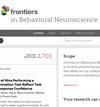Post-weaning social isolation alters sociability in a sex-specific manner
IF 2.6
3区 医学
Q2 BEHAVIORAL SCIENCES
引用次数: 0
Abstract
Adolescence is a critical period for brain development in humans and stress exposure during this time can have lasting effects on behavior and brain development. Social isolation and loneliness are particularly salient stressors that lead to detrimental mental health outcomes particularly in females, although most of the preclinical work on social isolation has been done in male animals. Our lab has developed a model of post-weaning adolescent social isolation that leads to increased drug reward sensitivity and altered neuronal structure in limbic brain regions. The current study utilized this model to determine the impact of adolescent social isolation on a three-chamber social interaction task both during adolescence and adulthood. We found that while post-weaning isolation does not alter social interaction during adolescence (PND45), it has sex-specific effects on social interaction in young adulthood (PND60), potentiating social interaction in male mice and decreasing it in female mice. As early life stress can activate microglia leading to alterations in neuronal pruning, we next examined the impact of inhibiting microglial activation with daily minocycline administration during the first 3 weeks of social isolation on these changes in social interaction. During adolescence, minocycline dampened social interaction in male mice, while having no effect in females. In contrast, during young adulthood, minocycline did not alter the impact of adolescent social isolation in males, with socially isolated males exhibiting higher levels of social interaction compared to their group housed counterparts. In females, adolescent minocycline treatment reversed the effect of social isolation leading to increased social interaction in the social isolation group, mimicking what is seen in naïve males. Taken together, adolescent social isolation leads to sex-specific effects on social interaction in young adulthood and adolescent minocycline treatment alters the effects of social isolation in females, but not males.断奶后的社会隔离会以性别特异性的方式改变交际能力
青春期是人类大脑发育的关键时期,这一时期所承受的压力会对行为和大脑发育产生持久的影响。社会隔离和孤独是特别突出的应激源,会导致有害的心理健康结果,尤其是对雌性动物而言,尽管大多数有关社会隔离的临床前研究都是在雄性动物身上进行的。我们的实验室开发了一种断奶后青少年社会隔离模型,该模型会导致药物奖赏敏感性增加和边缘脑区神经元结构改变。目前的研究利用这一模型来确定青春期社会隔离对青春期和成年期三室社会互动任务的影响。我们发现,虽然断奶后的隔离不会改变青春期(PND45)的社会互动,但它会对成年期(PND60)的社会互动产生性别特异性影响,雄性小鼠的社会互动会增强,而雌性小鼠的社会互动会减弱。由于早期生活压力会激活小胶质细胞,导致神经元修剪的改变,因此我们接下来研究了在小鼠社会隔离的头三周内每天服用米诺环素抑制小胶质细胞激活对这些社会互动变化的影响。在青春期,米诺环素抑制了雄性小鼠的社会互动,而对雌性小鼠没有影响。相反,在小鼠的成年期,米诺环素并没有改变雄性小鼠青春期社会隔离的影响,与集体饲养的雄性小鼠相比,被社会隔离的雄性小鼠表现出更高水平的社会互动。在女性中,青春期米诺环素治疗逆转了社会隔离的影响,导致社会隔离组的社交互动增加,模仿了在天真男性中看到的情况。综上所述,青少年时期的社会隔离会对成年后的社会交往产生性别特异性影响,而青少年米诺环素治疗会改变社会隔离对女性的影响,但不会改变对男性的影响。
本文章由计算机程序翻译,如有差异,请以英文原文为准。
求助全文
约1分钟内获得全文
求助全文
来源期刊

Frontiers in Behavioral Neuroscience
BEHAVIORAL SCIENCES-NEUROSCIENCES
CiteScore
4.70
自引率
3.30%
发文量
506
审稿时长
6-12 weeks
期刊介绍:
Frontiers in Behavioral Neuroscience is a leading journal in its field, publishing rigorously peer-reviewed research that advances our understanding of the neural mechanisms underlying behavior. Field Chief Editor Nuno Sousa at the Instituto de Pesquisa em Ciências da Vida e da Saúde (ICVS) is supported by an outstanding Editorial Board of international experts. This multidisciplinary open-access journal is at the forefront of disseminating and communicating scientific knowledge and impactful discoveries to researchers, academics, clinicians and the public worldwide.
This journal publishes major insights into the neural mechanisms of animal and human behavior, and welcomes articles studying the interplay between behavior and its neurobiological basis at all levels: from molecular biology and genetics, to morphological, biochemical, neurochemical, electrophysiological, neuroendocrine, pharmacological, and neuroimaging studies.
 求助内容:
求助内容: 应助结果提醒方式:
应助结果提醒方式:


